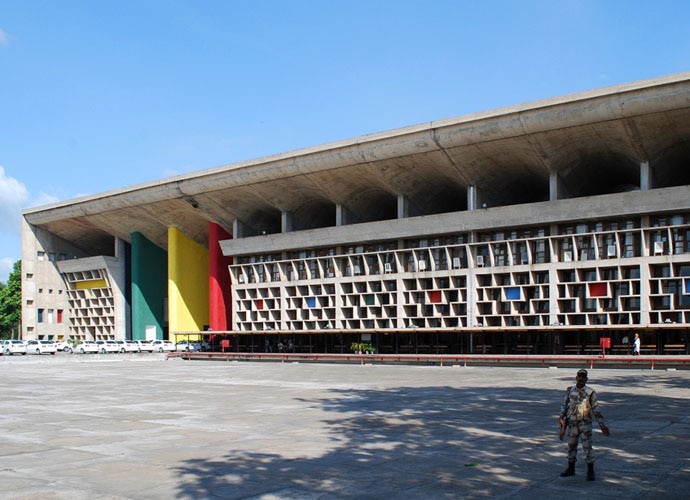Why Chandigarh was a smart city way ahead of its time

The United Nations Organisation for Education, Science and Culture (UNESCO) inscribed Chandigarh's Capitol Complex as World Heritage Site at the 40th session of World Heritage Conference in Istanbul, Turkey.
This arrived as a pleasant surprise for residents of the city. Accompanying the surprise is a sense of pride.
Most importantly, the Capitol's ordainment as World Heritage Site should remind us of its history and meaning, well documented by Ravi Kalia, Vikramditya Prakash and many others.
On the occasion of Chandigarh's 50th anniversary, a huge conference was organised with great architects of the world, historians and administrators as speakers.
It culminated into a thick volume that gives us valuable insights into the city we all admire for its many achievements. Chandigarh was born as a direct result of a violent period of Indian history - the Partition. Jawaharlal Nehru, India's first prime minister, laid down the principles of the new city.
On his first visit to Chandigarh on April 2, 1952, he said, "The site chosen is free from existing encumbrances of old towns and old traditions. Let it be the first large experience of our creative genius flowering on our newly earned freedom."
Conceived immediately after India's Independence in 1947, Chandigarh was designed by French architect Charles-Édouard Jeanneret, popularly known as Le Corbusier. The site was selected in early 1948 and three years later, the master plan was completed.
The high court, the Assembly and the Secretariat - Le Corbusier's most revered creations - form the Capitol Complex. The idea was to house the judiciary, legislative and executive powers of Punjab together.
 |
| Chandigarh High Court, Capitol Complex. |
The powerful imagery is obviously aimed at being more than a mere representation of provincial government. Stanislaus Von Moos, in his book Le Corbusier: Elements of a Synthesis, raises some interesting points: "The palaces of the three powers in Chandigarh's Capitol Complex mark the climax of Le Corbusier's career. As a built form, they represent the fulfilment of ideas and concepts that had been developed, questioned and redefined during a long and partly still unexplored process covering the whole of architect's creative lifetime."
Speaking of its design, French author and critic William Jr Curtis argues, "The main buildings of the Capitol combine a sense of formality with fluidity of space, and seem to 'slide' over the site."
Le Corbusier's own comments on the architecture of the Chandigarh are reflection of a deeper idea. He says, "The high court is the majesty and the shelter of the law."
Nothing was random in Chandigarh. "The spaciousness of greenery of Chandigarh is not merely aesthetic but part of a polemic about social wellness", he argued.
Chandigarh was the symbol of a developing, progressive and free India. A pragmatic mix of the functional and the aesthetic is the essence behind the architecture of the city.
It is also the first planned city of India. The wide tree-lined roads, unique architecture, greenery, the Rock Garden and its citizens - all characterise a city of the future, with no baggage of the past.
The "inauguration" of Chandigarh has some conflicting dates. Jawaharlal Nehru's visit to village Nagla on April 2, 1952 is considered the beginning according to the Census department.
According to The Tribune, which has comprehensively reported the growth and troubles of the city, the capital officially shifted from Shimla to Chandigarh on September 21, 1953, though Chandigarh was formally inaugurated by India's first president, Dr Rajendra Prasad on October 7, 1953.
The Chandigarh administration has traced its origins to 1948, the year the official decision to build the city was taken.
In British India, Lahore was the administrative city of the province of Punjab. In 1947, it was divided into an eastern and a western part upon the recommendation made by Radcliffe, an English lawyer and politician.
Eastern Punjab became part of India. With its adoption within India came the huge refugee problem. In order to settle the refugees, the government began to expand the existing towns into new suburbs called "model towns".
Punjab still needed a new administrative capital. Existing towns couldn't accommodate the refugees. Nehru recognised the problem and found a more comprehensive solution.
"Many people will be settled in Delhi, Bombay and other places. But there is a limited scope for expansion in big cities. There is, therefore, need for establishing new towns and cities," Nehru said in a speech, addressing a public meeting in Delhi on January 16, 1948.
The search for the capital of Punjab too had its own story. Eight different towns in the province of Punjab were considered for the new provincial capital.
Finally, it was decided that an entirely new town would become the capital. The Chandigarh experience can stand as a valuable lesson to the makers and takers of the idea of smart cities.

